Benny Goodman: Sing, Sing, Sing
[purchase]
My last couple of postings haven’t been all that popular with the readership. I’m not sure why an instrumental cello cover of a King Crimson song, or a difficult Velvet Underground song featuring a droning viola might not be all that attractive…..So to try to pander to the readers and rack up views, I’m going to write about a 12 minute jazz song that was performed in 1938. I suspect that it will blow up the Internet!
When the great clarinetist and bandleader Benny Goodman considered playing a concert at New York’s Carnegie Hall in the late 1930s, jazz had never been performed there. Initially concerned that jazz would not go over well at the bastion of classical music propriety, it was only after his movie, Hollywood Hotel, was a hit, that Goodman decided to go for it, and canceled recording dates to rehearse inside the venerable venue. Goodman’s initial concerns about financial success proved unfounded, when the 2760 seats sold out weeks in advance—the best seats cost $2.75, but third balcony and standing room seats cost 85 cents (depending on the website, $2.75 then is worth somewhere between $30 and $55 today, which is not bad, considering that if you wanted to go to Carnegie Hall next February to see Jon Batiste, the tickets range from $46-$65—but if you wanted to see Michael Feinstein, it would set you back between $83-$100).
Goodman’s orchestra was racially mixed, which was also groundbreaking for its time, and many writers have remarked that this concert was the point at which jazz became respectable (although some might consider that a bad thing, I guess).
In addition to performances by Goodman’s small groups and big band, there was a jam session that included members of the Count Basie and Duke Ellington orchestras. But the finale was what Goodman considered a “killer-diller” designed to get the patrons up and dancing—the Louis Prima penned “Sing, Sing, Sing.” As a brief aside, my introduction to this great song was when my high school band director, Mr. Sitts, had us play a marching band arrangement of the song at halftime of a football game. What I most remember about that was that I was playing bass drum, and had to keep a steady beat with one hand, while playing another rhythm with my other hand, which to this day, I remember being difficult. But Clarkstown North had a pretty strong marching band back in those days, so we did what we had to do.
The song begins with drumming from the great Gene Krupa, who had zero problems playing independent rhythms with both hands and feet, and eventually, pretty much everyone gets a solo, with Goodman’s appearing to ascend above the clarinet’s range. The song brought the audience to its feet, with some dancing in the aisles, not something that happened during the classical performances at Carnegie Hall.
The concert was recorded onto acetates as well as on aluminum transcription discs, but were not released contemporaneously because Goodman was distracted by other projects, and because of the use of musicians from various bands, there were difficult contractual issues to resolve. The aluminum discs, which were of higher quality, were filed away by CBS and forgotten. In 1950, Goodman’s niece, who had taken over his apartment, found the degraded acetate, and through difficult work, much of it was restored, and similarly difficult legal work cleared the music for release in 1950, becoming one of the first 33 1/3 records to sell over a million copies. Phil Schaap, who passed away on Tuesday, found a second set of acetates and worked to improve the quality, and the album was re-released in 1985. In 1998, a CD version was released based on the aluminum masters, improving the sound quality again, and there have been various CD releases and remasters since.































































































































































































































































































































































































